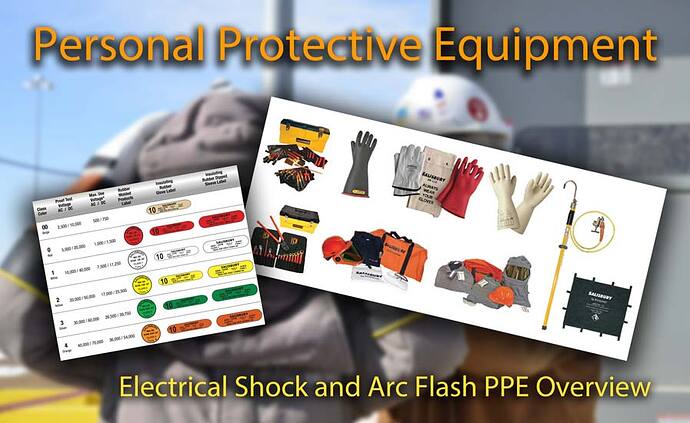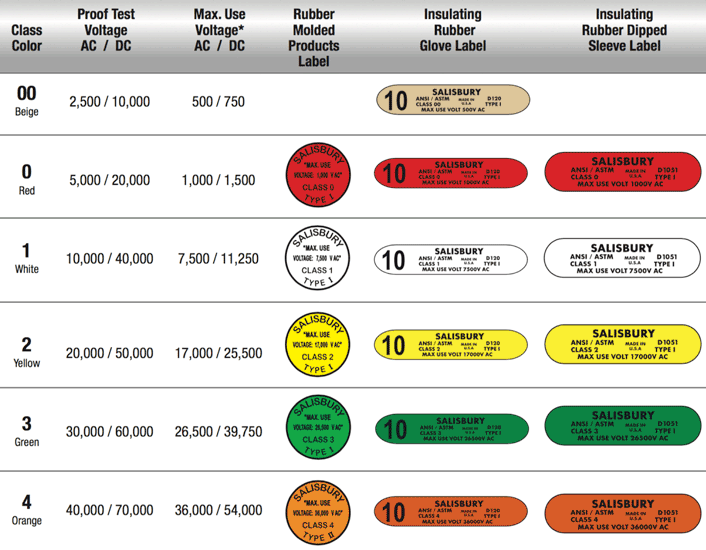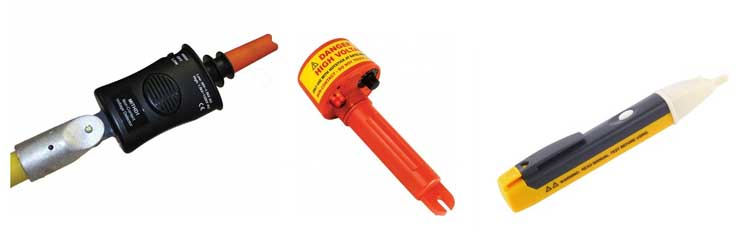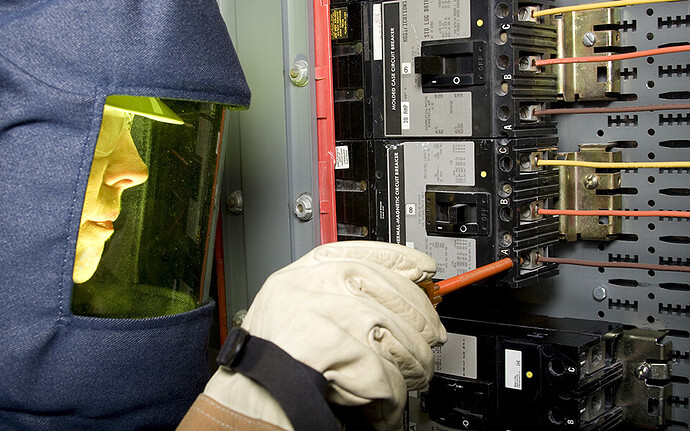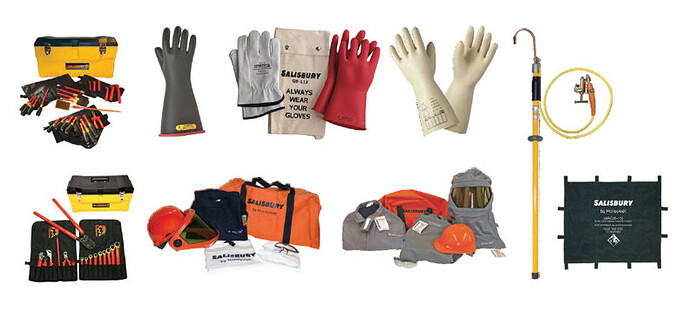Electricity has long been recognized as a serious workplace hazard, exposing employees to electric shock, electrocution, burns, fires, and explosions. Hundreds of deaths and thousands of injuries occur each year on the job due to electrical shock and arc flash, yet almost all of these tragic events are preventable.
In addition to being properly qualified for the task at hand, personal protective equipment (PPE), including arc flash-rated clothing, can provide additional safeguards against the hazards posed by working around electrical energy.
This guide provides a general overview of the various PPE that may be necessary for safe electrical work, including insulated gloves or sleeves, face shields, footwear, eye or hearing protection, and other electrical protective equipment.
Contents
- Safety Glasses and Goggles
- Hard Hats
- Dielectric Footwear
- Arc Flash Clothing
- Rubber Insulating Gloves and Sleeves
- PPE Hazard Risk Categories
- Electrical Safety Tools
- Important Points to Remember
- Relevant Standards
- Disclaimer
- References
1. Safety Glasses and Goggles
Eye protection is required whenever there is danger of injury to the eyes or face from arc flash or from flying objects resulting from electrical explosion. OSHA mandates the use of ANSI Z87.1 certified safety eyewear (OSHA 1910.335(a)(1)(v)) and also requires employers to provide the eye protection appropriate for the particular hazards involved with the current task.
Safety glasses for electrical work should be non-conductive, anti-fogging, anti-scratch, and anti-static with 99.9% UV protection. Goggles are intended for eye protection only - they do not provide face protection.
If working where there is a threat of injury to the eyes and face from electrical arc flash, safety glasses and goggles should be used with an Arc Flash Hood, hard hat, and arc-rated face shield with a chin cup.
2. Hard Hats
OSHA standards mandate that a hard hat must be worn “when working in areas where there is a potential for injury to the head from falling objects.” Hard hats must also be worn in working areas where there is the risk of exposure to electrical conductors that can potentially contact the head.
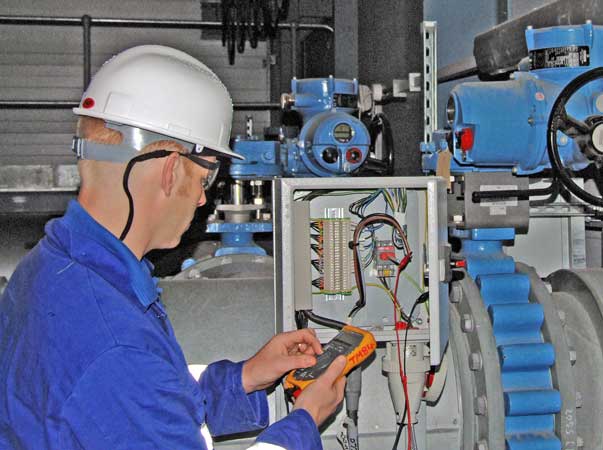
Wearing a hard hat is one of the easiest ways to protect the most important part of your body - the head. Photo: Wikimedia
Class E Hard Hats are designed to reduce exposure to high voltage conductors and offer dielectric protection up to 20,000 volts (phase to ground). This amount of voltage protection is designated for the head only and is not an indication of the overall voltage protection allocated to the worker.
Related: Hard Hat Classifications and Head Protection Basics
3. Dielectric Footwear
Electrical shock-resistant (EH) footwear is manufactured with non-conductive electrical shock-resistant soles and heels. It must be capable of withstanding the application of 14,000 volts at 60 hertz for one minute with no current flow or leakage current in excess of 3.0 milliamperes under dry conditions.
According to OSHA, employees must use protective footwear when their feet are exposed to electrical hazards. The employer is responsible for ensuring that each affected employee uses protective footwear when working in areas where there is a danger of foot injuries due to falling or rolling objects, or objects piercing the sole, and where such employees’ feet are exposed to electrical hazards. See OSHA 1910.136(a).
Related: How Electricity Affects Your Body
4. Arc Flash Clothing
Flame-resistant (FR) clothing significantly reduces burn injuries, which can save lives in the event of an accident. If employees are working in a potentially dangerous environment where heat or flame hazards are present, it is the responsibility of the employer to ensure that workers are sufficiently protected (OSHA 29 CFR 1910.269).
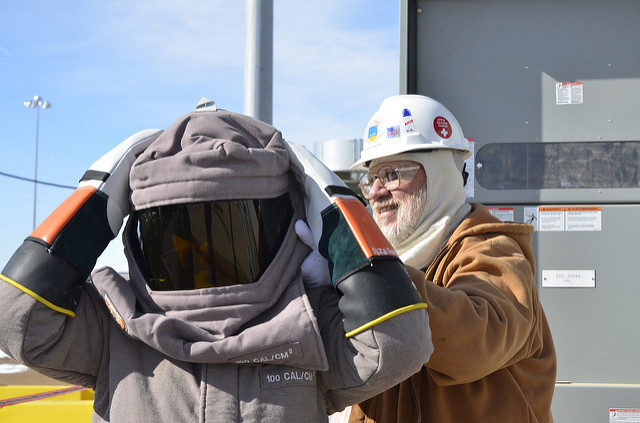
It is the responsibility of the employer to ensure that workers are sufficiently protected.
Protective clothing includes items such as shirts, pants, coveralls, hoods, jackets, rainwear, and parkas. Flame-resistant clothing is usually made out of cotton, cotton-synthetic blends, synthetics, or leather. Some synthetics are inherently flame-resistant while other clothing may be chemically treated for flame resistance.
Note: ASTM F1506 is the primary safety standard for arc flash protective clothing in the United States. The standard provides specifications for testing and rating clothing with an electric arc.
Arc Flash Protection Ratings
Based on the test results, arc flash ratings are determined for the clothing based on its resistance to the amount of incident thermal energy to which it is exposed from the arc. The rating assigned is based on the estimated onset of second-degree burns.
The arc flash rating is called the Arc Thermal Performance Value (ATPV), which is expressed in calories per square centimeter (cal/cm2) or joules per square centimeter (J/cm2). Clothing is available with ATPV ratings from approximately four to greater than 50 cal/cm2 (16.7 to 209 J/cm2).
Note: The arc rating can be found on the clothing label, per the requirements of ASTM F1506. It’s important not to confuse protective clothing designed for use against flash fires with clothing that has been designed for use against electric arcs.
| Hazard Risk Category | Minimum Performance |
|---|---|
| HRC 1 | 4 cal/cm2 |
| HRC 2 | 8 cal/cm2 |
| HRC 3 | 25 cal/cm2 |
| HRC 4 | 40 cal/cm2 |
See hazard risk categories for more information.
Arc Flash Clothing Maintenance
Some clothing might need to be dry cleaned if contaminated with grease or certain solvents. The flame resistance of chemically treated garments can decrease with the number of washings, and failure to remove grease and solvents from inherently flame-resistant or chemically treated PPE could compromise its protective properties.
Care must be taken to follow the decontamination and laundering instructions provided by the manufacturer to ensure that the PPE maintains its integrity. Some clothing cannot be washed with bleach, and the use of starch and softeners may not be recommended.
There are two standards that provide guidance on industrial and home laundering of flame resistant PPE:
-
ASTM F1449-08, Standard Guide for Industrial Laundering of Flame, Thermal, and Arc Resistant Clothing
-
ASTM F2757-09, Standard Guide for Home Laundering Care and Maintenance of Flame, Thermal and Arc Resistant Clothing.
Arc Flash Hood (balaclava)
Arc flash hoods provide 360 degree head and neck protection from arc flash dangers, when used with an arc rated face shield. According to NFPA 70E, an arc rated hood should be used when the anticipated incident energy exposure exceeds 12 cal/cm2.
Thermal ratings for balaclavas generally range from 10 to 28 cal/cm2. In order to achieve 360 degree 20 cal/cm2 protection, a 20 cal/cm2 balaclava must be worn.
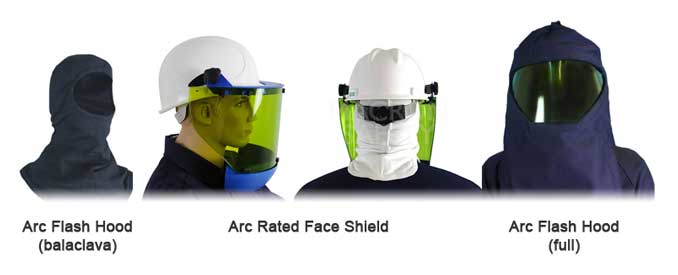
Arc flash hoods provide 360 degree head and neck protection from arc flash dangers, when used with an arc rated face shield.
Arc Rated Face Shield
To protect the head, eyes, and face from arc flash hazards, arc-rated face shields are attached to arc-rated hard hats and worn over an arc flash balaclava with safety glasses. When performing switching operations, turning and facing toward the hazard will prevent the face shield from becoming a heat scoop in the event of an arc flash.
Note: Hard hats designed for use with arc-flash clothing typically have an ATVP rating of 12cal/cm² or more.
Arc Flash Hood (Full)
The arc-rated flash hood is a single-piece hard hat and face shield combination encapsulated by flame-resistant fabric. Arc flash hoods fully cover the head and neck, offering much higher thermal ratings than the standard arc-rated face shield. Safety glasses and a balaclava should be worn in conjunction with the arc flash hood.
Arc Flash Gloves
These gloves are used for thermal protection only and range anywhere from 12 to 100 cal/cm2. It’s important to recognize that arc flash gloves do not provide electrical shock protection. Do not use these gloves when insulating rubber gloves are required.
Arc Flash Blanket

Arc suppression blankets help limit the explosive and incendiary effects of arc flash. Photo: Licensed Electrician
The Arc Suppression Blanket is used as a barrier for protection from the explosive and incendiary effects of electrical arcs and flashes. The blanket can be used for worker protection in underground vaults, switchyards, and other locations where electrical equipment poses a risk of exposure to explosive electrical discharges.
Like arc-rated gloves, it’s important to know that these blankets are not electrically insulated. Because electrical discharges are completely unpredictable, the arc suppression blanket may not totally contain an arc flash but only reduce or limit explosive and incendiary effects. In such cases, injuries may still occur, even when the blanket is properly used.
5. Rubber Insulating Gloves and Sleeves
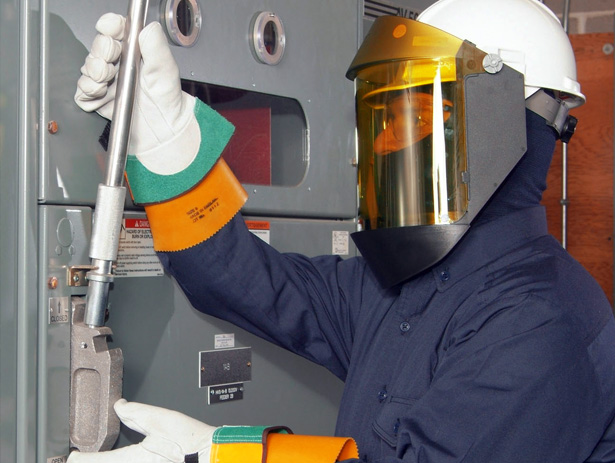
Leather protector gloves should always be worn over insulating rubber gloves.
Insulating rubber gloves are among the most important articles of personal protection an electrical worker can wear. To be effective, electrical safety gloves must incorporate dielectric properties and physical strength, along with flexibility and durability.
Type
Rubber is susceptible to the effects of ozone, which can cause cracking and compromise the integrity of the glove. If the gloves are used in an environment where the levels of ozone are high due to pollution, ozone resistance is critical.
There are two “types” of rubber glove:
-
Type I glove is not ozone-resistant. These gloves can be negatively affected by ozone and UV rays, rendering them unsafe.
-
Type II is ozone-resistant. These gloves are not as susceptible to ozone and UV rays, however they are not as flexible as Type I and therefore more uncomfortable to wear.
Classification
Protective gloves are categorized into six classifications, each based on the approved voltage levels the gloves can provide protection for. Rubber insulating gloves are electrically proof tested at voltage levels specified by ASTM D120-14a prior to being issued.
Protective gloves are categorized into six classifications, each based on the approved voltage levels the gloves can provide protection for. Photo: Western United Electric Supply Corp.
Leather Protectors
To provide the necessary mechanical protection against cuts, abrasions, and punctures, leather protector gloves should always be worn over insulating rubber gloves. Do not use leather protectors alone for protection against electric shock. Serious injury or death will result.
Liner Gloves
Liner gloves reduce the discomfort of wearing rubber insulating gloves. Liners provide warmth in cold weather and absorb perspiration in the warm months. These gloves should never be used alone for protection against electric shock.
Rubber Blankets
Just like with rubber insulating gloves, rubber blankets must be rated for the voltage of the parts being covered (phase to ground or phase to phase) and are designated from Class 0 (up to 1KV) through Class 4 (up to 36KV).
Care and Inspection of Rubber Goods
In order to maintain the highest level of protection and ensure long life, it is essential that rubber goods are properly cared for and stored. Before each use, rubber goods should be visually inspected for holes, rips, or tears, ozone cutting, UV checking, and signs of chemical deterioration, contamination, physical damage, and embedded wires.
Proper care of leather protectors is also essential to worker safety. Inspect the leather protectors when inspecting rubber gloves. Metal particles, embedded wire, abrasive materials, or any substance that could physically damage the rubber gloves must be removed from the protector before use.
Common problems to lookout for:
-
Embedded Wires: Inspect for embedded wires or metal shavings that could puncture rubber gloves.
-
Cracking & Cutting: Look for damage caused by prolonged folding or compressing.
-
UV Damage: Storing in areas exposed to prolonged sunlight causes UV damage.
-
Chemical Attack: Swelling caused by oils and petroleum compounds.
-
Folding: The strain on rubber at a folded point is equal to stretching the rubber to twice its length.
-
Snags: Damage due to wood and metal splinters and other sharp objects.
-
Storing Inside Out: Storing reversed gloves strains the rubber severely and promotes ozone cutting.
-
Contamination: Discard protectors contaminated with oil or petroleum compounds.
-
Physical Damage: Rope burns, deep cuts and puncture hazards are cause for rejection.
Note: Refer to ASTM F1236, Standard Guide for Visual Inspection of Electrical Protective Rubber Products for additional information.
Rubber Insulating Glove Inflation
Inflating rubber insulating gloves makes cuts, tears, or ozone damage easier to detect. Using a portable inflator, expand the gloves no more than 1.5 times their normal size for Type 1, and 1.25 times for Type 2. Listen for escaping air to detect holes.
If a portable inflator is unavailable, roll the cuff tightly to trap air inside, then apply pressure to areas of the glove to inspect for escaping air. Repeat the procedure with the glove turned inside out.
Sleeve Inspection
Rubber sleeves should be inspected along the edge as they are rolled. Rolling will stretch the sleeve along the edge, making cuts, tears, and ozone cutting more visible. Repeat the process with the sleeve turned inside out.
Rubber Blanket Inspection
Before each use, roll blankets to locate scratches, tears, abrasions, snags, corona cutting, or age-cracking. The blankets should be rolled two times on each side, with the second roll at a right angle to the first.
Blankets that show any signs of damage should be removed from service. A visual inspection in the field should be performed at least every 6 months.
Rubber Goods Storage
Proper storage extends the service life of gloves and sleeves, as folds and creases strain rubber and cause it to crack from ozone prematurely. By storing rubber gloves and sleeves in the right-size bag or roll-up, and never forcing more than one pair into each bag, equipment will lie flat and last longer.
Blankets should always be stored flat or rolled in blanket roll-ups or canisters. They should never be folded, creased, or compressed in any manner.
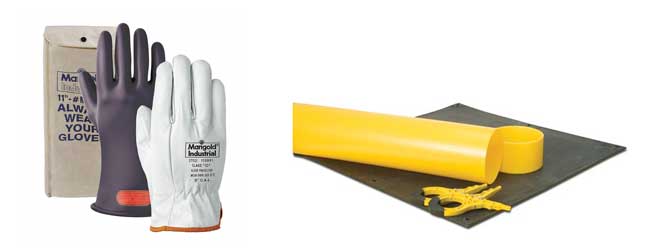
By storing equipment in the right size bag or roll-up, rubber gloves and blankets will lie flat and last longer.
When more than one blanket is stored, the most convenient method of loading is to roll and insert each blanket into the canister independently. A single blanket can then be removed without removing the others.
Do not use tape of any kind to hold the blankets in the rolled position; the adhesive can damage the blanket surfaces. Both Type I and Type II blankets are subject to damage by petroleum-based products.
Rubber Safety Equipment Testing
In addition to the daily inspection, OSHA requires electrical safety equipment to be subjected to periodic electrical tests as specified in 29 CFR 1910.137(c)(2)(viii). Rubber insulating gloves must be tested before first issue and every six months thereafter; upon indication that the insulating value is suspect; after repair; and after use without protectors.
If the insulating gloves have been electrically tested but not issued for service, they may not be placed into service unless they have been electrically tested within the previous 12 months. The ASTM In-Service Specifications call for an electrical retest of blankets at least every 12 months.
OSHA 29 CFR 1910.137 Testing Schedule
| Item | When to test |
|---|---|
| Line Hose | Upon indication that insulating value is suspect and after repair. |
| Covers | Upon indication that insulating value is suspect and after repair. |
| Blankets | Before first issue and every 12 months thereafter; 1 upon indication that insulating value is suspect; and after repair. |
| Gloves | Before first issue and every 6 months thereafter; 1 upon indication that insulating value is suspect; after repair; and after use without protectors. |
| Sleeves | Before first issue and every 12 months thereafter; 1 upon indication that insulating value is suspect; and after repair. |
Tip: An alternating glove color program is suggested to help ensure all gloves in use are in the proper test cycle. This program creates a visual reminder of the proper test cycle by using one color for the first six months and a different color for the following six months.
6. PPE Hazard Risk Categories
NFPA 70E Standard for Electrical Safety in the Workplace specifies areas where arc flash protection is required for workers involved in the maintenance of energized or potentially energized electrical equipment. All personnel within the defined boundaries must wear specified protective equipment, even on circuits as low as 50 volts.
Related: NFPA 70E Arc Flash and Shock Hazard Boundaries Explained
The greater the electrical hazard, the higher the personal protective equipment arc rating must be to withstand an arc-flash incident. Please note that the following list is only a summary. For the complete list of NFPA standards, see NFPA 70E Table 130.7(C)(16).
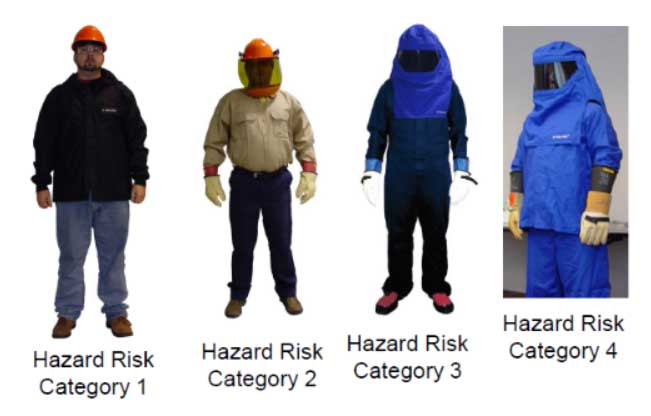
The greater the electrical hazard, the higher the personal protective equipment arc rating must be to withstand an arc-flash incident. Photo: EFCOG Electrical Safety Task Group.
PPE CATEGORY 1
- Arc-Rated Long-Sleeve Shirt and Pants or
- Arc-Rated Coverall
- Arc-Rated Face shield or Arc Flash Suit hood
- Arc-Rated Jacket, Parka,or Rainwear (AN)
- Hard Hat
- Safety Glasses or Safety Goggles (SR)
- Hearing Protection (Ear Canal Inserts)
- Heavy Duty Leather Gloves*
- Leather work Shoes (AN)
PPE CATEGORY 2
- Arc-Rated Long-Sleeve Shirt and Pants or
- Arc-Rated Coverall
- Arc Flash Suit Hood or Arc-Rated Face
- Shield and Arc-Rated Balaclava
- Arc-Rated Jacket, Parka, or Rainwear (AN)
- Hard Hat
- Safety Glasses or Safety Goggles (SR)
- Hearing Protection (Ear Canal Inserts)
- Heavy Duty Leather Gloves*
- Leather work Shoes
PPE CATEGORY 3
- Arc-Rated Long-Sleeve Shirt (AR)
- Arc-Rated Pants (AR)
- Arc-Rated Coverall (AR)
- Arc-Rated Arc Flash Suit Jacket (AR)
- Arc-Rated Arc Flash Suit Pants (AR)
- Arc-Rated Arc Flash Suit Hood
- Arc-Rated Gloves or Rubber Insulating
- Gloves with Leather Protectors (SR)
- Arc-Rated Jacket, Parka, Rainwear or Hard
- Hat Liner (AN)
- Hard Hat
- Safety Glasses or Safety Goggles (SR)
- Hearing Protection (Ear Canal Inserts)
- Leather Work Shoes
PPE CATEGORY 4
- Arc-Rated Long-Sleeve Shirt (AR)
- Arc-Rated Pants (AR)
- Arc-Rated Coverall (AR)
- Arc-Rated Arc Flash Suit Jacket (AR)
- Arc-Rated Arc Flash Suit Pants (AR)
- Arc-Rated Arc Flash Suit Hood
- Arc-Rated Gloves or Rubber Insulating
- Gloves with Leather Protectors (SR)
- Arc-Rated Jacket, Parka, Rainwear or Hard
- Hat Liner (AN)
- Hard Hat
- Safety Glasses or Safety Goggles (SR)
- Hearing Protection (Ear Canal Inserts)
- Leather Work Shoes
Key
- AN = As Needed (optional)
- AR = As Required
- SR = Selection Required
7. Electrical Safety Tools
Aside from protective clothing, electrical safety tools help keep qualified workers protected from hazardous voltage when working with and around energized equipment.
Non-Contact Voltage Detectors
Non-contact voltage detectors are used to verify live or de-energized conductors. These testers may be used with insulating rubber gloves or hot sticks using the splined universal end fitting.
Proximity voltage testers indicate the presence of voltage with an LED light and/or a distinctive audible signal.
Voltage testers indicate the presence of voltage with an extra bright LED light and/or a distinctive audible signal. The tester is moved closer to the conductor until a warning is indicated, or it touches the conductor, apparatus, or test point.
Because the voltage detector alarms in the proximity of electric fields, it is not necessary to make physical contact with the equipment being checked. Because it is made of non-conductive materials, it will not conduct electricity and will not cause an arc flash even if contact with energized equipment is made.
Personal Protective Grounds
Protective grounding provides shock protection for technicians working on de-energized equipment. If done correctly, it is by far the most effective means of protection from electrical shock. Grounding cables need to be carefully selected to ensure the protection of technicians. Choosing the wrong size of cable or the wrong style of clamp can prove to be deadly.
Related: Applying and Removing Protective Grounds
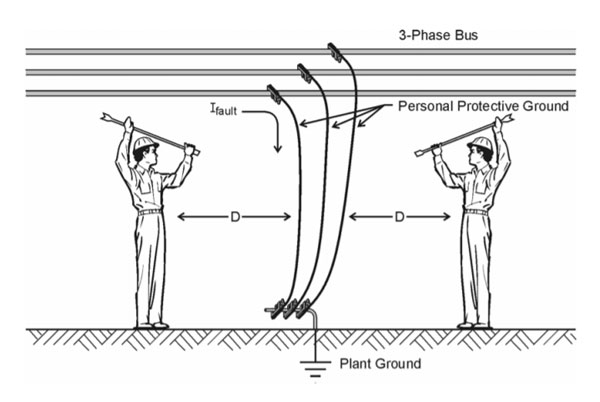
Personal protective grounds should be placed to create an equipotential zone at the work location. Safety grounds are sized with consideration to the available short circuit current and duration of the fault. Photo: USBR.
The primary considerations when selecting grounding cables are their withstand rating for fault current and their length. Choose the appropriate cable ampacity based on the calculated maximum fault current and chosen clearing time at the worksite. The conductors must be made of multi-stranded copper and can be no smaller than 2 AWG.
Electric shock and the potential for arc flash are the two main hazards of applying personal protective grounds. Reference NFPA 70B Table 13.7(C)(15)(a) for the appropriate selection of PPE.
Insulated Hand Tools
When working near exposed energized conductors use insulated tools in the event you make contact with energized conductors or parts.
To fully comply with OSHA 1910.333 and NFPA 70E, insulated hand tools must be used. A complete insulated tool program should be in place to meet these standards. The insulating material used should be impact-resistant and flame retardant.
Layered two-color insulation makes inspection easier, which adds to overall safety. If the yellow under layer is showing, the tool may no longer be insulated properly and should be considered for electrical retesting.
Every insulated hand tool is rated for exposure up to 1,000 VAC and dielectrically tested at 10,000 VAC. Tools should meet or exceed current ASTM F1505-07 and IEC 900 Standards for Insulated Hand Tools.
OSHA 1910.335(a)(2)(i) When working near exposed energized conductors or circuit parts, each employee shall use insulated tools or handling equipment if the tools or handling equipment might make contact with such conductors or parts. If the insulating capability of insulated tools or handling equipment is subject to damage, the insulating material shall be protected.
Insulated Rescue Hooks and Hot Sticks
Rescue hooks keep the rescuer at a safe distance while remaining insulated from the injured worker who may still be in contact with live parts.
Insulated rescue hooks are used to withdraw an injured worker out of a hazardous area. Confined spaces, in vaults, or just near electrical cabinets and switchgear are some of the places where this tool is a must.
Hook sticks are typically available in the standard lengths of 6 and 8 feet. Rescue hooks keep the rescuer at a safe distance while remaining insulated from the injured worker who may still be in contact with live parts.
A hot stick is an electrically insulated pole, usually made of fiberglass, used when working on energized high-voltage systems to protect from electric shock. Depending on the tool attached to the end of the hot stick, it is possible to test for voltage, tighten nuts and bolts, apply protective grounds, open and close switches, replace fuses, lay insulating sleeves on wires, and perform various other tasks without exposing workers to a large risk of electric shock.
Static Discharge Stick
The Static Discharge Stick is designed to safely remove the static charge from electrical power equipment after de-energizing. This tool is pre-assembled and includes a brass alloy “U” hook, closed-cell foam-filled tubular fiberglass switch stick made in accordance with ASTM Standard F711. Copper grounding cable is attached to the stick for discharging high voltage feeders and other capacitive equipment.
8. Important points to remember about PPE
-
The maximum arc flash protection of a kit is equal to the lowest cal/cm2 rating of any component in the selected safety kit.
-
Clothing selected for a particular application shall have an arc thermal performance value higher than the potential hazard to prevent the onset of 2nd degree burns.
-
To keep PPE in top condition, proper storage is very important. Proper storage extends the service life of rubber safety equipment. Folds and creases strain natural rubber and cause it to cut from ozone prematurely.
-
NFPA 70E does not have a Hazard Risk Category above 40 cal/cm2. Working on levels above 40 cal/cm2 should be avoided because of the blast hazards caused by arc flash.
-
The need for additional PPE can be minimized by confirming that there is no electrical hazard present before work is performed.
-
Clothing made from acetate, nylon, polyester, acrylic, polyethylene and rayon, in either pure or blended forms, should not be worn when working in hazardous environments.
-
Breathability matters. According to OSHA, workers are at greater risk of heat stress while using bulky or non-breathable protective clothing and equipment. If the body cannot get rid of excess heat, it will store it. When this happens, the body’s core temperature rises, and the heart rate increases. As the body continues to store heat, the person begins to lose concentration and has difficulty focusing on a task, may become irritable or sick, and often loses the desire to drink. Exposure to heat can also increase the risk of injuries because of sweaty palms, lens fogging, and dizziness.
-
NFPA 70E requires that all electrical workers who operate within the Flash Protection Boundary must wear arc flash clothing and understand arc flash clothing requirements.
-
NFPA 70E Table 130.7 lists the appropriate level of PPE for use when encountering hazardous electrical areas.
-
Arc rated flame resistant clothing is designed to resist ignition and to protect against the thermal energy released by an arc flash. It does not offer protection against the physical injury that may occur from flying objects or high-pressure sound wave, which can accompany an arc flash.
9. Relevant Standards
- OSHA 29 CFR 1910
- NFPA 70E Standard for Electrical Safety in the Workplace
- ASTM D120 Rubber Insulating Gloves
- ASTM D178 Rubber Insulating Matting
- ASTM D1048 Rubber Insulating Blankets
- ASTM D1049 Rubber Insulating Covers
- ASTM D1050 Rubber Insulating Line Hose
- ASTM D1051 Rubber Insulating Sleeves
- ASTM F478 In-Service Care of Line Hose & Covers
- ASTM F479 In-Service Care of Insulating Blankets
- ASTM F496 In-Service Care of Gloves & Sleeves
- ASTM F696 Leather Protectors for Insulating Gloves and Mittens
- ASTM F1236 Inspection Guide for Rubber Products
- ASTM F1742 PVC Insulating Sheeting
- ASTM F2320 Rubber Insulating Sheeting
- ASTM F2677 Electrically Insulating Aprons
- ASTM F1505-07 Insulated and Insulating Hand Tools
- ASTM F1959 Thermal protective value of textiles in an electric arc application
- ASTM F1506 textiles to be used by an electrical worker as a means of electrical arc protection
- ASTM F2178 test method used to measure arc rated products intended to protect the face of workers exposed to electrical arcs.
10. Important Disclaimer
This guide is presented for informational purposes only and should not be used in place of recognized industry standards. NFPA 70E Standard for Electrical Safety in the Workplace requires employers to perform an Electrical Arc Hazard Assessment. Each situation is unique and needs to be evaluated on its own merits.
